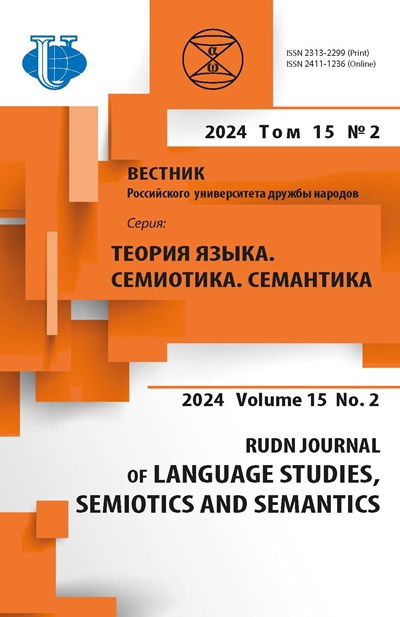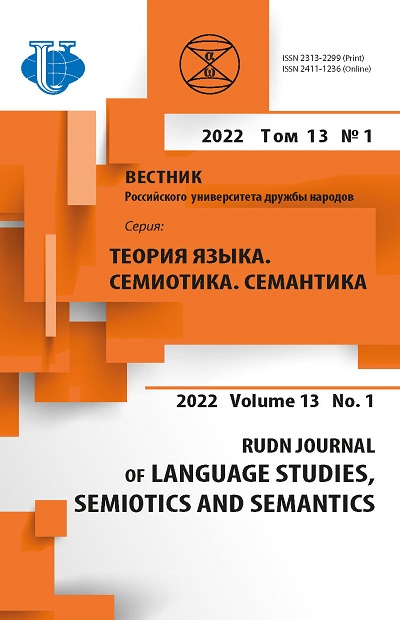Метафорическая репрезентация коронавируса в медицинских мифах
- Авторы: Степанова Е.С.1
-
Учреждения:
- Самарский государственный медицинский университет
- Выпуск: Том 13, № 1 (2022)
- Страницы: 174-183
- Раздел: СОЦИОКОГНИТИВНЫЕ ИССЛЕДОВАНИЯ
- URL: https://journals.rudn.ru/semiotics-semantics/article/view/30707
- DOI: https://doi.org/10.22363/2313-2299-2022-13-1-174-183
Цитировать
Полный текст
Аннотация
Статья посвящена метафорической репрезентации коронавируса в медицинских мифах на примере британских СМИ. Для достижения этой цели используется дескриптивная теория метафоры для анализа метафорических моделей концептуализации коронавируса. Информация о вирусе, передаваемая СМИ, коррелирует с фоновыми знаниями реципиента, приобретает новые концептуальные характеристики, которые отражаются в медицинских мифах. Гипотеза исследования заключается в том, что метафорическая репрезентация коронавируса в медицинских мифах представлена дескриптивной метафорой, содержание которой меняется в зависимости от специфики распространения вируса, а также политической ситуации в стране. Исходной предпосылкой для исследования является предположение о том, что метафорические значения в медицинских мифах влияют на представление о болезни, которое отражает не только общие представления об этом заболевании, но и формирует общественное мнение о политической ситуации в лингвокультурном обществе. Цель этого исследования - проанализировать заголовки и лиды британской прессы о коронавирусе и интерпретировать метафорические модели концептуализации коронавируса, используемые в медицинских мифах. Цель исследования обусловила выбор методов исследования: контент-анализ заголовков и лидов, содержащих метафорические модели для концептуализации коронавируса в медицинских мифах; выборочный анализ, направленный на выявление и описание функций метафорических моделей для репрезентации болезни в медицинских мифах. Нами были использованы понятия метаязыка, такие, как «сигнификативный дескриптор» и «денотативный дескриптор», которые позволяют описывать функционирование метафор. Результаты исследования показывают, что для концептуализации коронавируса в медицинских мифах используются следующие метафорические модели: «Коронавирус - военный соперник», «Коронавирус - стихийное бедствие» и «Коронавирус - луч надежды».
Ключевые слова
Об авторах
Елена Сергеевна Степанова
Самарский государственный медицинский университет
Автор, ответственный за переписку.
Email: pretty.step@bk.ru
SPIN-код: 6992-0076
кандидат филологических наук, доцент кафедры иностранных и латинского языков 443099, Российская Федерация, Самара, ул. Чапаевская, д. 89
Список литературы
- King K.C., Hoffman J.R. Myths and medicine // Western Journal of Medicine. 2000. № 172 (3). C. 208. https://doi.org/10.1136/ewjm.172.3.208
- Lakoff G., Johnson M. Metaphors we live by. Chicago: University of Chicago Press, 1980.
- Kövecses Z. Conceptual metaphor theory // The Routledge Handbook of Metaphor and Language. New York: Routledge, 2016. pp. 13—27.
- Davidson D. What Metaphors Mean // Reference, Truth and Reality: Essay on the Philosophy of Language. London, 1980. pp. 238—254.
- Searle R.J. Metaphor // Metaphor and Thought, Andrew Ortony (ed.). Cambridge: Cambridge University Press, 1984. pp. 92—124.
- Walter J., Helmig J. Metaphors as Agents of Signification. Towards a Discursive Analysis of Metaphors. In: ECPR Granada Workshop Metaphors in Political Science, 2005. URL: https://seis.bristol.ac.uk/~potfc/Granada/Papers/Helmig.pdf (accessed: 01.03.2021).
- Simpson P., Mayr A., Statham S. Critical Linguistics and Critical Discourse Analysis // Language and Power. Milton Park, Abingdon, Oxon; New York: Routledge, 2018. pp. 58—65.
- Charteris-Black J. Corpus approaches to critical metaphor analysis. Hampshire: Palgrave Macmillan, 2004.
- Simpson P., Mayr A., Statham S. Critical Metaphor Analysis // Language and Power. Milton Park, Abingdon, Oxon, New York: Routledge, 2018. pp. 229—236.
- Sweetser E. From etymology to pragmatics: metaphorical and cultural aspects of semantic structure. Cambridge: Cambridge University Press, 1990.
- Turner M., Fauconnier G. Conceptual Integration and Formal Expression // Metaphor and Symbolic Activity. 1995. № 10 (3). P. 183—203.
- Ricoeur P. The rule of Metaphor: the Creation of Meaning in Language. London, New York: Routledge, 2004.
- Баранов А.Н. О типах сочетаемости метафорических моделей // Вопросы языкознания. 2003. № 2. С. 73—94. (In Russ.).
- Zinken J., Hellsten I., Nerlich B. Discourse metaphors // Body, Language, and Mind, R. Dirven, R. Frank, T. Ziemke, J. Zlatev (eds.). Vol. 2: Sociocultural Situatedness. Berlin: Mouton, 2008. pр. 363—385.
- Li W. Rethinking Critical Metaphor Analysis // International journal of English Linguistics. 2016. № 6 (2). Р. 92.
- Stepanova E.S. Linguocognitive Specifics of the Disease Myth // Вестник Российского университета дружбы народов. Серия: Теория языка. Семиотика. Семантика. 2021. № 12 (1). С. 153—164. https://doi.org/10.22363/2313-2299-2021-12-1-153-164
Дополнительные файлы
Нет дополнительных файлов для отображения













